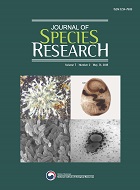A report on 57 unrecorded bacterial species in Korea in the classes Betaproteobacteria and Gammaproteobacteria
차창준 (중앙대학교)
조장천 (인하대학교)
임완택 (한경대학교)
장광엽 (전북대학교)
전체옥 (중앙대학교)
조기성 (한국외국어대학교)
김승범 (충남대학교)
성치남 (순천대학교)
김원용 (중앙대학교)
이하나 (고려대학교)
이순동 (제주대학교)
윤정훈 (성균관대학교)
배진우 (경희대학교)
- 다운로드 수
- 조회수
Abstract
In an investigation of indigenous prokaryotic species in Korea, a total of 57 bacterial strains assigned to the classes Betaproteobacteria and Gammaproteobacteria were isolated from diverse environments. Samples were collected from fresh water, natural caves, soil, paddy fields, lakes, sea water, jeotgal (fermented seafood), salt flats, soil from abandoned mines, plant roots, digestive organs of both Japanese crested ibis (Nipponia nippon) and Burmese python (Python molurus bivittatus) and tidal flats. From the high 16S rRNA gene sequence similarity (>98.7%) and formation of robust phylogenetic clades with closely related species, it was determined that each strain belonged to an independent and predefined bacterial species within either the Betaproteobacteria or Gammaproteobacteria. There is no official report or publication that describes these 57 proteobacterial species in Korea. Overall, in the class Betaproteobacteria there were 16 species in 12 genera of 4 families in the order Burkholderiales and two species in two genera of one family in the order Neisseriales. Within the class Gammaproteobacteia, there were five species in four genera of four families in the order Alteromonadales, 12 species in 11 genera of one family in the order Enterobacteriales, four species in four genera of three families in the order Oceanospirillales, 11 species in four genera of two families in the order Pseudomonadales, two species in the order Vibrionales and five species in five genera of one family in the order Xanthomonadales. Gram reaction, colony and cell morphology, basic biochemical characteristics, isolation source and strain IDs are described in the species description section.
- keywords
- 16S rRNA, Bacterial diversity, Betaproteobacteria, Gammaproteobacteria, Unrecorded species
참고문헌
Kim, O.S., Y.J. Cho, K. Lee, S.H. Yoon, M. Kim, H. Na, S.C. Park, Y.S. Jeon, J.H. Lee, H. Yi, S. Won and J. Chun 2012. Introducing EzTaxon-e: a prokaryotic 16S rRNA gene sequence database with phylotypes that represent uncultured species. International Journal of Systematic and Evolutionary Microbiology 62(Pt3):716-721.
Kluge, A.G. and F.S. Farris. 1969. Quantitative phyletics and the evolution of anurans. Systematic Zoology 18(1):1-32.
Lane, D.J. 1991. 16S/23S rRNA sequencing. In: Nucleic acid techniques in bacterial systematics John Wiley and Sons, New York, NY.
Lauber, C.L., M. Hamady, R. Knight and N. Fierer. 2009. Pyrosequencing-based assessment of soil pH as a predictor of soil bacterial community structure at the continental scale. Applied and Environmental Microbiology 75(15):5111-5120.
Loman, N.J. and M.J. Pallen. 2015. Twenty years of bacterial genome sequencing. Nature Reviews Microbiology 13(12):787-794.
Pascault, N., S. Roux, J. Artigas, S. Pesce, J. Leloup, R.D. Tadonleke, D. Debroas, A. Bouchez and J.F. Humbert. 2014. A high-throughput sequencing ecotoxicology study of freshwater bacterial communities and their responses to tebuconazole. FEMS Microbiology Ecology 90(3):563-574.
Saitou, N. and M. Nei. 1987. The neighbor-joining method:a new method for reconstructing phylogenetic trees. Molecular Biology and Evolution 4(4):406-425.
Shigematsu, T., M. Hayashi, I. Kikuchi, S. Ueno, H. Masaki and T. Fujii. 2009. A culture-dependent bacterial community structure analysis based on liquid cultivation and its application to a marine environment. FEMS Microbiology Letters 293(2):240-247.
Shin, N.R., T.W. Whon and J.W. Bae. 2015. Proteobacteria:microbial signature of dysbiosis in gut microbiota. Trends in Biotechnology 33(9):496-503.
Tamura, K., D. Peterson, N. Peterson, G. Stecher, M. Nei and S. Kumar. 2011. MEGA5: molecular evolutionary genetics analysis using maximum likelihood, evolutionary distance, and maximum parsimony methods. Molecular Biology and Evolution 28(10):2731-2739.
Thompson, J.D., T.J. Gibson, F. Plewniak, F. Jeanmougin and D.G. Higgins. 1997. The CLUSTAL_X windows interface: flexible strategies for multiple sequence alignment aided by quality analysis tools. Nucleic Acids Research 25(24):4876-4882.
- 다운로드 수
- 조회수
- 0KCI 피인용수
- 0WOS 피인용수


